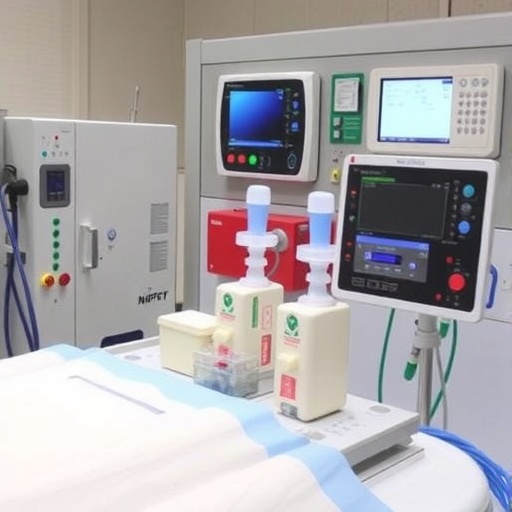In recent years, the field of organ transplantation has witnessed remarkable advances, yet the quest for improving graft survival and patient outcomes continues to pose significant challenges. One of the most promising innovations in this arena is normothermic machine perfusion (NMP), a technique that allows donated organs, particularly kidneys, to be preserved and evaluated at physiological temperatures prior to transplantation. The latest comprehensive study by Rabelink, Hosgood, Minor, and colleagues, published in Nature Communications, delves deep into the opportunities and hurdles surrounding the implementation of NMP in kidney transplantation. Their findings not only advance our understanding of organ preservation but also highlight critical areas needing refinement and rigorous clinical validation.
Normothermic machine perfusion departs fundamentally from traditional cold storage methods by maintaining the kidney in a warm, oxygenated, and metabolically active state outside the body. This approach preserves the organ’s cellular and vascular integrity far better than simple hypothermic preservation, potentially mitigating ischemia-reperfusion injury that often compromises graft function once transplanted. By providing continuous oxygen supply and nutrients, NMP keeps the kidney “alive” in a near-physiological environment, allowing not only preservation but also real-time functional assessment and therapeutic intervention.
.adsslot_C6LmoNIgD4{ width:728px !important; height:90px !important; }
@media (max-width:1199px) { .adsslot_C6LmoNIgD4{ width:468px !important; height:60px !important; } }
@media (max-width:767px) { .adsslot_C6LmoNIgD4{ width:320px !important; height:50px !important; } }
ADVERTISEMENT
Despite these advantages, the authors emphasize several technical and logistical challenges inherent in widespread NMP implementation. For instance, the machinery required for normothermic perfusion is complex and costly, necessitating specialized training and infrastructure in transplant centers. This increases the resource burden and limits accessibility, especially in low- and middle-income settings where the need for improving organ utilization is arguably greatest. Additionally, standardization of perfusion protocols remains an unmet need, with variability in pressure settings, perfusate composition, and duration potentially influencing outcomes.
The biological mechanisms by which NMP confers protective effects warrant further exploration. The study outlines emerging evidence that NMP not only reduces ischemic injury but may also modulate immune activation and mitigate inflammatory cascades triggered by transplantation. The ability to “recondition” kidneys during ex vivo perfusion might open avenues for targeted drug delivery to the organ, providing localized anti-inflammatory or regenerative therapies prior to implantation. Such possibilities underscore the versatility of NMP beyond mere preservation.
From a clinical trials perspective, the authors report promising but still early-stage data supporting the safety and efficacy of NMP. Several pilot studies indicate improved early graft function and reduced delayed graft function incidence. However, larger multicenter randomized controlled trials with long-term follow-up are essential to establish definitive benefits in survival and quality of life. Regulatory approvals and harmonized guidelines will also depend on accumulating robust evidence of reproducibility and cost-effectiveness.
In addition to kidney transplantation, the potential applications of normothermic machine perfusion extend to other solid organs such as the liver, lung, and heart. While each organ presents unique perfusion demands and vulnerabilities, the foundational principle of maintaining physiological conditions ex vivo offers transformative potential across the transplantation landscape. Cross-disciplinary collaboration will be pivotal to adapting and optimizing NMP protocols for diverse organ types.
The environmental impact of increased use of disposable components in machine perfusion systems also merits consideration. Sustainable design and waste reduction strategies are necessary to ensure that this cutting-edge technology’s ecological footprint is minimized, aligning with broader healthcare goals of environmental responsibility.
Training surgeons, perfusionists, and healthcare teams to expertly operate and interpret NMP data is a critical component being addressed through specialized courses and simulation-based education. Capacity building will enable the safe and effective scaling of NMP, with professional societies playing a key role in establishing competency standards.
Patient perspectives and psychosocial factors tied to NMP transplantation remain underexplored. Understanding how recipients perceive this evolving technology and its impact on their transplant experience will inform counseling and consent processes, ultimately fostering shared decision-making.
Finally, the economic implications of adopting normothermic machine perfusion must be weighed against potential cost savings from improved graft longevity and reduced complications. Health economic modeling and real-world cost-effectiveness studies will provide vital insights for policymakers and healthcare payers.
In conclusion, normothermic machine perfusion stands at the forefront of a new era in kidney transplantation. The study by Rabelink and colleagues articulates a comprehensive vision of this technology’s transformative promise alongside the pragmatic considerations for its integration into clinical practice. As ongoing research addresses outstanding questions and technological refinements continue apace, NMP is poised to reshape the transplant landscape, offering hope for enhanced graft survival and improved quality of life for patients worldwide.
Subject of Research: Normothermic machine perfusion in kidney transplantation
Article Title: Opportunities and challenges with the implementation of normothermic machine perfusion in kidney transplantation
Article References:
Rabelink, T.J., Hosgood, S., Minor, T. et al. Opportunities and challenges with the implementation of normothermic machine perfusion in kidney transplantation. Nat Commun 16, 6883 (2025). https://doi.org/10.1038/s41467-025-60410-3
Tags: challenges in kidney transplant proceduresclinical validation of NMPdonor organ evaluation methodsgraft survival improvementimpact of NMP on patient outcomesischemia-reperfusion injury mitigationkidney transplantation advancementsnormothermic machine perfusionorgan preservation techniquesphysiological temperature organ storagereal-time functional assessment of organstransplant innovation and technology





